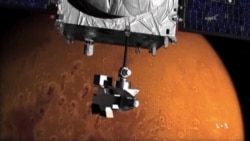NASA’s newest Mars probe, called MAVEN, has successfully entered its designated orbit around the "red planet." Scientists will use its sophisticated instruments to try to learn what happened to the atmosphere Mars had a few billion years ago.
After a 10-month, 711-million kilometer journey, MAVEN’s thrusters slowed it down to enter into orbit Sunday around Mars.
MAVEN, which stands for ‘Mars Atmosphere and Volatile Evolution Mission’, will try to find answers to two simple questions: “Where did the water go? Where did the carbon dioxide go?”
MAVEN principal investigator Bruce Jakosky says scientists now know that Mars once had a much denser atmosphere, but it changed significantly over the last few billion years when most of its gases disappeared into space. What they still don’t know is how and why that happened.
“We are trying to understand what the cause of that climate change has been, and we are looking at the role that escape to space may have played in removing the atmosphere, and changing the atmosphere,” he said.
Implications of study
MAVEN will be exploring the top layers of what’s left of the Martian atmosphere, because scientists think that charged particles emitted by the sun, the so-called “solar wind”, may have been responsible for slowly stripping away the atmospheric gasses, including water vapor.
Learning about how Mars lost its water is key to understanding if the planet most like Earth in the solar system ever could have supported life.
It will take five weeks for the spacecraft to deploy its booms, get calibrated and be ready for work, before beginning the one-year mission which carries a price tag of $671 million.
Right now, NASA’s engineers are still celebrating the fact that so far the mission went without a glitch.
“It really is an amazing amount of work that the team did to make it look so smooth tonight," he said. "It is kind of cliched, people walk around going 'it is not rocket science', well sometimes it is rocket science.”
Other 'explorers'
MAVEN has joined two American and one European spacecraft orbiting the Red Planet, together with three rovers still operating on its surface. In two days, India’s first Mars explorer should enter its orbit where it will also conduct atmospheric measurements.
Maven is NASA's 21st shot at Mars and the first since the Curiosity rover landed on the red planet in 2012.
Just this month, Curiosity arrived at its prime science target, a mountain named Sharp, ripe for drilling. The Opportunity rover is also still active a decade after landing.
All these robotic scouts are paving the way for the human explorers that NASA hopes to send in the 2030s. The space agency wants to understand as much about the red planet as possible before it sends people there, AP reported.
Some material for this report came from Reuters and AP.










